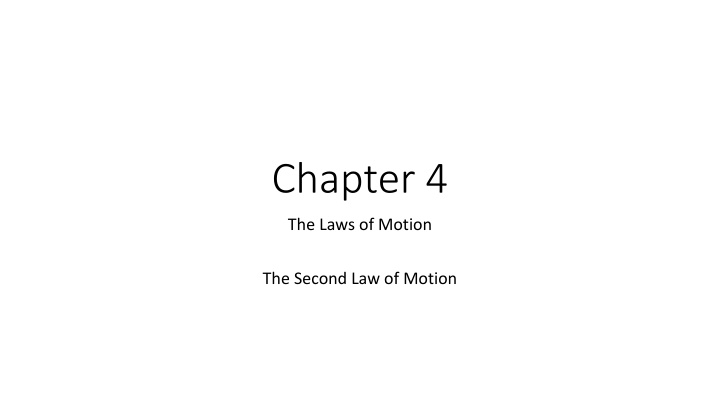Chapter 4
Second Law of Motion by delving into force, acceleration, mass relationships. Learn how the net force affects acceleration in objects of different masses. Practice problems for a better grasp.
Download Presentation

Please find below an Image/Link to download the presentation.
The content on the website is provided AS IS for your information and personal use only. It may not be sold, licensed, or shared on other websites without obtaining consent from the author.If you encounter any issues during the download, it is possible that the publisher has removed the file from their server.
You are allowed to download the files provided on this website for personal or commercial use, subject to the condition that they are used lawfully. All files are the property of their respective owners.
The content on the website is provided AS IS for your information and personal use only. It may not be sold, licensed, or shared on other websites without obtaining consent from the author.
E N D
Presentation Transcript
Chapter 4 The Laws of Motion The Second Law of Motion
The Second Law of Motion According to Newton s first law of motion, unbalanced forces cause the velocity of an object to change Newton s second law of motion describes how the net force on an object, its mass, and its acceleration are related
The Second Law of Motion Force and Acceleration Think about throwing a ball to a person standing in front of you some distance away If you throw the ball hard vs throw it gently, what differs? The net force (greater when you throw the ball hard) The velocity (greater change in velocity as the hard thrown ball leaves your hand) What s the formula for acceleration again? So which ball has the greater acceleration (the hard or gently thrown one)? So to conclude, the greater the force, the greater the acceleration
The Second Law of Motion Mass and Acceleration AS THE MASS OF AN OBJECT IS INCREASED, THE ACCELERATION DECREASES
The Second Law of Motion To put it all together The Second Law of Motion states that the acceleration of an object is in the same direction as the net force You can calculate this using the formula Acceleration = Net force (in Newtons)/Mass (in kg) a=F/m Units = m/s F= m x a Units = N
The Second Law of Motion Let s practice! If the mass of a helicopter is 4500 kg and the net force on it is 18000 N, what is the helicopter s acceleration? a = ? F = 18000 N m = 4500 kg a = F/m = 18000 N/4500 kg = 4 m/s You push a friend on a sled. Your friend and the sled together have a mass of 70 kg. If the net force on the sled is 35 N, what is the sled s acceleration? a = F = m =
The Second Law of Motion What is the net force on a dragster with a mass of 900 kg if its acceleration is 32 m/s ? a = F = m = A car is being pulled by a tow truck. What is the car s mass if the net force on the car is 3000 N and it has an acceleration of 2 m/s ? a = F = m =
Which would hurt more?... (which applies more FORCE?) An elephant (5000 kg) running into you at 2 m/s2 OR A mouse (800 g = _________ kg) running into you at 50 m/s2 (use F=ma to solve!)














